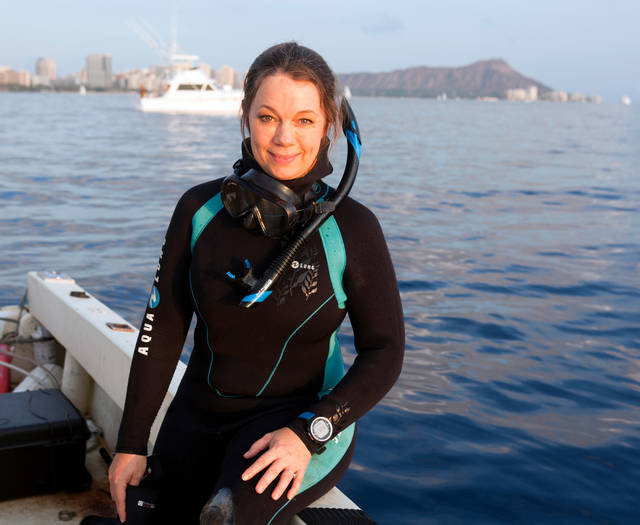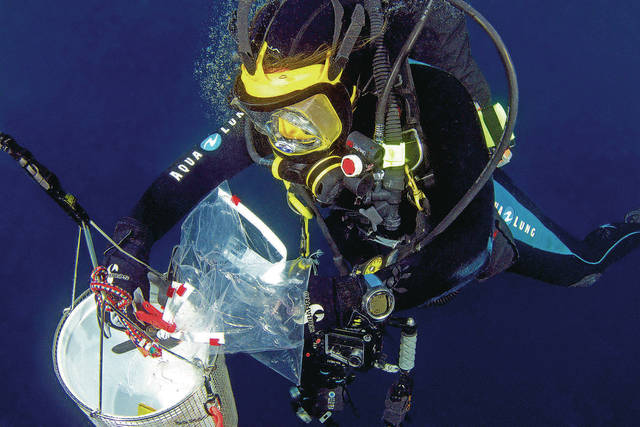2 scientists refute online cures for jellyfish stings

COURTESY UNIVERSITY OF HAWAII AT MANOA
Angel Yanagihara’s research contradicts methods of removing jellyfish found online on WebMD and the Mayo Clinic’s website.

COURTESY UNIVERSITY OF HAWAII AT MANOA
Researcher Angel Yanagihara captures some Hawaiian box jellyfish off the shores of Oahu.


To cope with the searing pain of a Hawaiian box jellyfish sting, resist the urge to reach for an ice pack. Don’t even rinse the inflamed area with seawater.
And never scrape box jelly tentacles off your skin with a credit card.
The three “remedies,” commonly touted on reputable medical websites, will only exacerbate an already serious problem, according to a new study by University of Hawaii researchers published March 15 in the journal Toxins.
“We put those methods to the test in the lab and found they actually make stings much, much worse in the long run,” said Angel Yanagihara, lead author of the report and assistant research professor at the UH Pacific Biosciences Research Center and the UH medical school.
| TREATING THE PAIN
How to handle a Hawaiian box jellyfish sting: Don't miss out on what's happening!Stay in touch with breaking news, as it happens, conveniently in your email inbox. It's FREE!
By clicking to sign up, you agree to Star-Advertiser's and Google's Terms of Service Opens in a new tab and Privacy Policy Opens in a new tab. This form is protected by reCAPTCHA.
Do’s >> Do rinse with vinegar. >> Do immerse in hot water. Don’ts >> Don’t rinse with seawater. >> Don’t use ice. >> Don’t scrape with a credit card. Source: “Cubozoan Sting-Site Seawater Rinse, Scraping, and Ice Can Increase Venom Load: Upending Current First Aid Recommendations,” Toxins, March 15 |
She and co-author Christie Wilcox, a postdoctoral fellow at the medical school, found that rinsing the sting area with vinegar and then applying hot water or a heat pack was the best solution in the field using readily available items.
The researchers experimented with a wide range of treatments for box jelly stings. They included dousing with fresh water, seawater, vinegar or a baking soda slurry; applying ice or heat; scraping off tentacles with a plastic card or plucking them with tweezers; and using Sting No More spray and cream.
Some of the findings of their rigorous lab tests are counterintuitive. Seawater is commonly seen as innocuous, as are ice packs — but in this case they are dangerous.
“People want to apply ice because of the burning sensation,” Yanagihara said in an interview. “But they don’t understand that by adding ice you’re preserving that venom, so you are going to make things far worse.”
“Applying seawater will massively spread the sting area,” she added. “And applying ice increases the ultimate devastation to the tissue zone by orders of magnitude.”
Worldwide, box jellyfish are responsible for more deaths than sharks each year, according to the journal article. The researchers experimented with the Hawaiian box jelly, Alatina alata, and the more dangerous Australian box jelly, Chironex fleckeri. The tentacles of the Australian species are especially sticky and could not be removed with vinegar alone.
First aid for box jellyfish stings requires a two-pronged strategy, said Yanagihara, a prolific scientist who has been researching jellyfish venom for 19 years. First, the tentacles and their stinging cells, which she describes as “tiny ticking time bombs,” must be inactivated and removed. Second, the venom that is already in the flesh must be treated.
“Less than 1 percent of stinging cells on a tentacle actually fire when you’re first stung,” noted Wilcox, the co-author. “So anything you do that moves the tentacles or adherent stinging cell capsules around has the potential to increase the amount of venom injected into you by many fold.”
Rinsing Hawaiian box jelly stings with vinegar prevents further damage by permanently inactivating the stinging cell capsules that have not yet fired. And using a heat pack or immersing in hot water, at 45 Celsius or 113 Fahrenheit, substantially reduces the activity of venom already injected into the flesh, the research showed.
The researchers found that scraping tentacles with a credit card had disastrous results: It vastly increased the number of stinging cells discharged. Vinegar, on the other hand, prevented discharge of those stingers and helped dislodge tentacles. Remaining tentacles could then be safely removed with tweezers.
To learn what happened when a sting was scraped, the researchers applied live box jelly tentacles to a skin-and-tissue model made from prepared pig intestine that was wrapped over a “blood agar.” To assess venom delivery and activity, they measured how many red blood cells suspended in agar gel were destroyed when exposed to fresh tentacles.
“The increases in venom injection and activity we saw in our study from methods like scraping and applying ice could mean the difference between life and death in a serious box jelly sting,” Yanagihara said.
The Toxins article faulted WebMD and the Mayo Clinic’s website for advising people to rinse jellyfish stings with seawater to “remove” or “deactivate” stingers, and for advising use of a credit card to scrape them off.
“It’s all too easy to find bad advice on treating jelly stings on the internet,” Wilcox said. “Even in the peer-reviewed literature, there are a lot of examples of recommendations that are made in passing in discussion sections without any direct evidence to back them up, and then those just keep getting repeated and cited over and over even though they’re not based on rigorous, empirical scientific evidence.”
The best solution for both Hawaiian and Australian box jellies was Sting No More spray and cream, previously developed by Yanagihara to treat stings in U.S. Special Operations Command combat divers. That Department of Defense contract required the results be commercialized, and the product is now available for sale.
Yanagihara abided by conflict-of-interest guidelines in the current study, which was funded by the Defense Department, National Institutes of Health and Hawaii Community Foundation.
In an article, “Heated Debate,” published in June in Toxins, Yanagihara and Wilcox reviewed the evidence in multiple jellyfish sting studies and concluded that hot-water immersion had good clinical outcomes. Previous experiments by the pair had also found vinegar to be effective.




